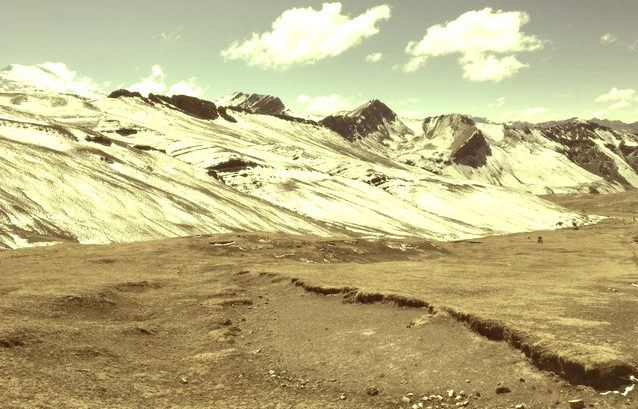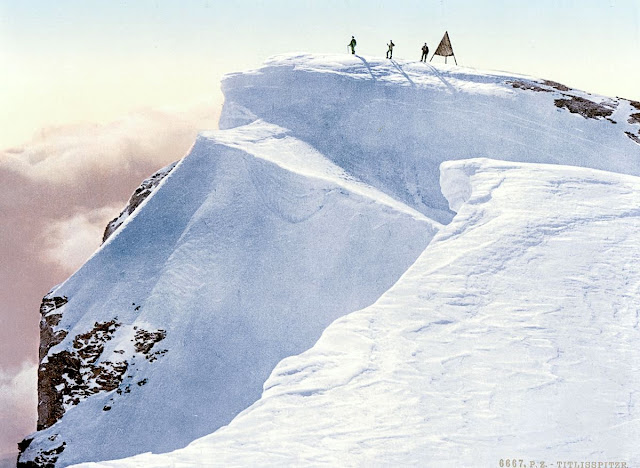VINTAGE POSTCARD 1949
Nanda Devi (7,816 m -25,643 ft)
India
©wandertngvertexes collection. All rights reserved
The mountain
Nanda Devi
(7,816 m -25,643 ft) is a two-peaked massif, forming a 2-kilometre-long (1.2 mi) high ridge, oriented east-west. Nanda Devi is the second highest mountain in India, and the highest located entirely within the country ;
Kangchenjunga, which is higher, is on the border of India and Nepal.
The western summit is higher, and the eastern summit is called Sunanda Devi formerly known as Nanda Devi East is the lower one. The main summit stands guarded by a barrier ring comprising some of the highest mountains in the Indian Himalayas, twelve of which exceed 6,400 m -21,000 ft in height, further elevating its sacred status as the daughter of the Himalaya in Indian myth and folklore. The interior of this almost insurmountable ring is known as the Nanda Devi Sanctuary, and is protected as the Nanda Devi National Park. Sunanda Devi lies on the eastern edge of the ring (and of the Park), at the border of Chamoli, Pithoragarh and Bageshwar districts.
Together the peaks may be referred to as the peaks of the goddesses Nanda and Sunanda.
In addition to being the 23rd highest independent peak in the world, Nanda Devi is also notable for its large, steep rise above local terrain. It rises over 3,300 metres (10,800 ft) above its immediate southwestern base on the Dakkhini Nanda Devi Glacier in about 4.2 kilometres (2.6 mi), and its rise above the glaciers to the north is similar. This makes it among the steepest peaks in the world at this scale, closely comparable, for example, to the local profile of
K2. Nanda Devi is also impressive when considering terrain that is a bit further away, as it is surrounded by relatively deep valleys. For example, it rises over 6,500 metres (21,300 ft) above the valley of the Goriganga in only 50 km (30 mi).
Climbing
The ascent of Nanda Devi necessitated fifty years of arduous exploration in search of a passage into the Sanctuary. The outlet is the Rishi Gorge, a deep, narrow canyon which is very difficult to traverse safely, and is the biggest hindrance to entering the Sanctuary; any other route involves difficult passes, the lowest of which is 5,180 m (16,990 ft). Hugh Ruttledge attempted to reach the peak three times in the 1930s and failed each time. In a letter to The Times he wrote that 'Nanda Devi imposes on her votaries an admission test as yet beyond their skill and endurance', adding that gaining entry to the Nanda Devi Sanctuary alone was more difficult than reaching the North Pole. In 1934, the British explorers Eric Shipton and H. W. Tilman, with three Sherpa companions, Angtharkay, Pasang, and Kusang, finally discovered a way through the Rishi Gorge into the Sanctuary.
When the mountain was later climbed in 1936 by a British-American expedition, it became the highest peak climbed by man until the 1950 ascent of
Annapurna. (However higher non-summit elevations had already been reached by the British on Mount Everest in the 1920s, and it is possible that George Mallory reached
Everest's summit in 1924.) It also involved steeper and more sustained terrain than had been previously attempted at such a high altitude. The expedition climbed the south ridge, also known as the Coxcomb Ridge, which leads relatively directly to the main summit. The summit pair were H. W. Tilman and Noel Odell; Charles Houston was to be in place of Tilman, but he contracted severe food poisoning. Noted mountaineer and mountain writer H. Adams Carter was also on the expedition, which was notable for its small scale and lightweight ethic: it included only seven climbers, and used no fixed ropes, nor any Sherpa support above 6,200 m (20,300 ft). Eric Shipton, who was not involved in the climb itself, called it
"the finest mountaineering achievement ever performed in the Himalaya."
After abortive attempts by Indian expeditions in 1957 and 1961, the second ascent of Nanda Devi was accomplished by an Indian team led by N. Kumar in 1964, following the Coxcomb route.
A difficult new route, the northwest buttress, was climbed by a 13-person team in 1976. Three Americans, John Roskelley, Jim States, and Lou Reichardt, summitted on 1 September. The expedition was co-led by Louis Richard, H. Adams Carter (who was on the 1936 climb), and Willi Unsoeld, who climbed the West Ridge of Everest in 1963. Unsoeld's daughter, Nanda Devi Unsoeld, who was named after the peak, died on this expedition. She had been suffering from "diarrhea and flare-up of an inguinal hernia, which had shown up originally on the second day of the approach march", and had been at 24,000 feet for nearly five days.
From 1965 to 1968, attempts were made by the Central Intelligence Agency (CIA), in co-operation with the Indian Intelligence Bureau (IB), to place a nuclear-powered telemetry relay listening device on the summit of Nanda Devi. This device was designed to intercept telemetry signals from missile test launches conducted in the Xinjiang Province, at a time of relative infancy in China's missile program. The expedition retreated due to dangerous weather conditions, leaving the device near the summit of Nanda Devi. They returned the next spring to search for the device, which ended without success. As a result of this activity by the CIA, the Sanctuary was closed to foreign expeditions throughout much of the 1960s. In 1974 the Sanctuary re-opened.
In 1980, the Indian Army Corps of Engineers made an unsuccessful attempt.
In 1981, the first women stood on the summit as part of a mixed Indian team, led by Col. Balwant Sandhu, Rekha Sharma, Harshwanti Bisht and Chandraprabha Aitwal, partnered by Dorjee Lhatoo, Ratan Singh and Sonam Paljor respectively, climbed on three ropes and summitted consecutively. The expedition was notable for the highest ascent ever made by Indian women up to that point in time, a descent complicated by retinal oedema and vision loss in the climbing leader and a subsequent failed claim of a solo ascent by a later member of the same expedition. All three women went on to
Everest in 1984 but did not make the summit although Sonam Paljor and Dorjee Lhatoo did. Dorjee Lhatoo climbed Sunanda Devi in 1975, she also participated in the 1976 Indo-Japanese expedition.
This was followed in 1981 by another Indian Army expedition of the Parachute Regiment, which attempted both main and eastern peaks simultaneously. The expedition had placed a memorial to Nanda Devi Unsoeld at the high altitude meadow of Sarson Patal prior to the attempt. The successful attempt lost all its summitteers.
In 1993, a 40-member team of the Indian Army from the Corps of Engineers was given special permission. The aim of the expedition was multifold – to carry out an ecological survey, clean up the garbage left by previous expeditions, and attempt the summit. The team included a number of wildlife scientists and ecologists from Wildlife Institute of India, Salim Ali Centre for Ornithology and Natural History, World Wide Fund for Nature and Govind Ballabh Pant Institute for Himalayan Environment and Development amongst others. The expedition carried out a comprehensive ecological survey and removed from the park, by porter and helicopter, over 1000 kilograms of garbage. Additionally, five summiteers scaled the summit: Amin Nayak, Anand Swaroop, G. K. Sharma, Didar Singh, and S. P. Bhatt.
In 1988, Nanda Devi National Park was declared a UNESCO World Heritage Site "of outstanding cultural or natural importance to the common heritage of humankind." The entire sanctuary, and hence the main summit (and interior approaches to the nearby peaks), are off-limits to locals and to climbing expeditions, though a one-time exception was made in 1993 for a 40-member team from the Indian Army Corps of Engineers to check the state of recovery and to remove garbage left by prior expeditions.
Sunanda Devi remains open from the east side, leading to the standard south ridge route.
Sources:
Vintage postcards
Postcards became popular at the turn of the 20th century, especially for sending short messages to friends and relatives. They were collected right from the start, and are still sought after today by collectors of pop culture, photography, advertising, wartime memorabilia, local history, and many other categories.
Postcards were an international craze, published all over the world. The Detroit Publishing Co. and Teich & Co. were two of the major publishers in the U.S, and sometimes individuals printed their own postcards as well. Yvon were the most famous in France. Many individual or anonymous publishers did exist around the world and especially in Africa and Asia (Japan, Thailand, Nepal, China, Java) between 1920 and 1955. These photographer were mostly local notables, soldiers, official guides belonging to the colonial armies (british french, belgium...) who sometimes had rather sophisticated equipment and readily produced colored photograms or explorers, navigators, climbers (Vittorio Sella and the Archiduke of Abruzzi future king of Italy remains the most famous of them).
There are many types of collectible vintage postcards.
Hold-to-light postcards were made with tissue paper surrounded by two pieces of regular paper, so light would shine through. Fold-out postcards, popular in the 1950s, had multiple postcards attached in a long strip. Real photograph postcards (RPPCs) are photographs with a postcard backing.
Novelty postcards were made using wood, aluminum, copper, and cork. Silk postcards–often embroidered over a printed image–were wrapped around cardboard and sent in see-through glassine paper envelopes; they were especially popular during World War I.
In the 1930s and 1940s, postcards were printed on brightly colored paper designed to look like linen.
Most vintage postcard collectors focus on themes, like Christmas, Halloween, portraits of movie stars, European royalty and U.S. presidents, wartime imagery, and photos of natural disasters or natural wonders. Not to mention cards featuring colorful pictures by famous artists like Alphonse Mucha, Harrison Fisher, Ellen Clapsaddle, and Frances Brundage.

















